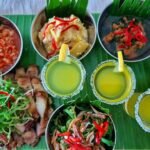
- arrow_back Home
- keyboard_arrow_right Things to do
10 Best Things to Do in the Philippines
Things to do 11 Andy March 21, 2025

Table of Contents
ToggleHere are 10 Best Things to Do in the Philippines curated by The Story Mojo
The Philippines, an archipelago of over 7,000 islands, is a tropical paradise known for its stunning beaches, vibrant culture, and warm hospitality. Whether you’re an adventure seeker, a history buff, or a beach lover, the Philippines offers a diverse range of experiences that cater to every type of traveler. Here’s a detailed guide on the top 10 things to do in the Philippines.
1. Explore the Breathtaking Beaches of Palawan

El Nido and Coron
Palawan is often referred to as the “Last Frontier” of the Philippines, and for good reason. The islands of El Nido and Coron are home to some of the most beautiful beaches and lagoons in the world.
- El Nido: Known for its towering limestone cliffs, crystal-clear waters, and hidden lagoons, El Nido offers a range of activities such as island hopping, snorkeling, and kayaking. Don’t miss the Big Lagoon and Small Lagoon, which are perfect for kayaking and swimming.
- Coron: Famous for its stunning coral reefs and shipwrecks, Coron is a paradise for divers. The Barracuda Lake and Twin Lagoon are must-visit spots for their unique underwater landscapes.
Puerto Princesa Underground River
A UNESCO World Heritage Site, the Puerto Princesa Underground River is one of the New7Wonders of Nature. Take a boat tour through this subterranean river to marvel at its impressive rock formations and underground ecosystem.
2. Dive into the Marine Wonderland of Tubbataha Reef

Tubbataha Reefs Natural Park
Located in the Sulu Sea, Tubbataha Reefs Natural Park is a UNESCO World Heritage Site and one of the best diving spots in the world. The reef is home to a diverse range of marine life, including sharks, turtles, and over 600 species of fish.
- Diving: The best time to visit Tubbataha is during the diving season from March to June. Liveaboard diving trips are the most popular way to explore this marine wonderland.
- Conservation: Tubbataha is a protected area, and diving here supports marine conservation efforts.
3. Experience the Cultural Richness of Manila

Intramuros
Step back in time with a visit to Intramuros, the historic walled city of Manila. This area is home to several Spanish-era landmarks, including Fort Santiago, San Agustin Church, and Casa Manila.
- Fort Santiago: A historic citadel that played a significant role during the Spanish colonial period. It’s also a memorial to national hero Jose Rizal.
- San Agustin Church: A UNESCO World Heritage Site and the oldest stone church in the Philippines.
Rizal Park
Also known as Luneta Park, this urban park is a great place to relax and learn about Philippine history. The park features the Rizal Monument, which honors the national hero, and various gardens and fountains.
4. Trek the Majestic Rice Terraces of Banaue
Banaue Rice Terraces
Often referred to as the “Eighth Wonder of the World,” the Banaue Rice Terraces are a testament to the ingenuity of the Ifugao people. These terraces were carved into the mountains over 2,000 years ago and are still in use today.
- Trekking: There are several trekking routes that take you through the terraces and nearby villages. The Batad Rice Terraces and Bangaan Village are particularly scenic.
- Cultural Experience: Stay in a traditional Ifugao hut and learn about the local culture and traditions.
5. Discover the Chocolate Hills of Bohol
Chocolate Hills
One of the most iconic landmarks in the Philippines, the Chocolate Hills are a series of over 1,200 cone-shaped hills that turn brown during the dry season, resembling chocolate mounds.
- Viewing Decks: The best way to see the Chocolate Hills is from the viewing decks in Carmen and Sagbayan.
- Adventure Activities: For the more adventurous, try ATV rides or zip-lining for a thrilling perspective of the hills.
Tarsier Sanctuary
While in Bohol, visit the Philippine Tarsier Sanctuary to see the world’s smallest primate. These tiny, nocturnal creatures are endemic to the Philippines and are a must-see for wildlife enthusiasts.
6. Relax on the White Sand Beaches of Boracay
White Beach
Boracay is famous for its powdery white sand beaches and vibrant nightlife. White Beach, the most popular beach on the island, is divided into three stations, each offering a different vibe.
- Station 1: Known for its luxury resorts and serene atmosphere.
- Station 2: The heart of Boracay’s nightlife, with numerous bars, restaurants, and shops.
- Station 3: A quieter area, perfect for those seeking a more relaxed experience.
Water Sports
Boracay offers a wide range of water sports, including parasailing, kiteboarding, and scuba diving. The island’s clear waters and vibrant marine life make it a great destination for underwater exploration.
7. Hike the Majestic Peaks of Mount Apo and Mount Pulag
Mount Apo
As the highest peak in the Philippines, Mount Apo offers a challenging yet rewarding trek. The mountain is home to diverse flora and fauna, including the endangered Philippine eagle.
- Trekking Routes: There are several routes to the summit, ranging from 2 to 4 days. The Kidapawan Trail and Kapatagan Trail are popular choices.
- Hot Springs: After your trek, relax in the Mainit Hot Springs at the base of the mountain.
Mount Pulag
Known for its “sea of clouds,” Mount Pulag is the third-highest peak in the Philippines and a favorite among hikers.
- Sea of Clouds: The best time to witness this natural phenomenon is during the early morning hours.
- Flora and Fauna: Mount Pulag is home to unique plant species and wildlife, including the dwarf bamboo and the Luzon cloud rat.
8. Immerse Yourself in the Festivals of Cebu and Davao
Sinulog Festival
Held every January in Cebu City, the Sinulog Festival is one of the most colorful and vibrant festivals in the Philippines. The festival honors the Santo Niño (Child Jesus) and features street dancing, parades, and religious processions.
Kadayawan Festival
Celebrated in Davao City every August, the Kadayawan Festival is a thanksgiving festival for the bountiful harvest. The festival features street dancing, floral floats, and indigenous performances.
9. Explore the Underground River and Caves of Puerto Princesa
Puerto Princesa Underground River
As mentioned earlier, the Puerto Princesa Underground River is a must-visit. The river flows through a cave system that features stunning rock formations and an underground ecosystem.
- Boat Tours: Guided boat tours take you through the cave, where you can see stalactites, stalagmites, and various species of bats and swiftlets.
- Wildlife: The surrounding area is home to diverse wildlife, including monkeys, monitor lizards, and various bird species.
Honda Bay
For more island-hopping adventures, visit Honda Bay, which is known for its pristine beaches and excellent snorkeling spots. Popular islands include Starfish Island, Cowrie Island, and Luli Island.
10. Experience the Unique Culture of the Cordillera Region
Sagada
Sagada is a small town in the Cordillera region known for its unique culture and stunning landscapes.
- Hanging Coffins: One of Sagada’s most famous attractions, the hanging coffins are a traditional burial practice of the Igorot people.
- Echo Valley: A popular spot for hiking and exploring the hanging coffins.
- Sumaguing Cave: Known as the “Big Cave,” it features impressive rock formations and underground pools.
Bontoc
Visit the Bontoc Museum to learn about the culture and history of the Igorot people. The museum features artifacts, traditional clothing, and exhibits on the region’s history.
Practical Tips for Traveling in the Philippines
Best Time to Visit
The best time to visit the Philippines is during the dry season, from November to April. This period offers the best weather for outdoor activities and beach vacations.
Visa Requirements
Most nationalities can enter the Philippines visa-free for up to 30 days. Check the specific visa requirements for your country before traveling.
Transportation
The Philippines has a well-developed transportation network, including domestic flights, ferries, and buses. For island-hopping, ferries and small boats are the most common modes of transport.
Language
The official languages are Filipino and English. English is widely spoken, making it easy for travelers to communicate.
Currency
The currency is the Philippine Peso (PHP). Credit cards are widely accepted in cities, but it’s advisable to carry cash in rural areas.
Safety
The Philippines is generally safe for travelers, but it’s always wise to take standard precautions. Be aware of your surroundings, avoid displaying valuables, and follow local advice.
Conclusion
The Philippines is a destination that offers something for everyone, from stunning beaches and vibrant festivals to rich cultural heritage and thrilling adventures. Whether you’re exploring the underwater wonders of Tubbataha Reef, trekking the majestic rice terraces of Banaue, or relaxing on the white sand beaches of Boracay, the Philippines promises an unforgettable experience. Plan your trip well, and you’ll discover why this tropical paradise is one of the most beloved destinations in Southeast Asia. Mabuhay! (Welcome!)
©2025 thestorymojo.com All rights reserved.





Be the first to leave a comment